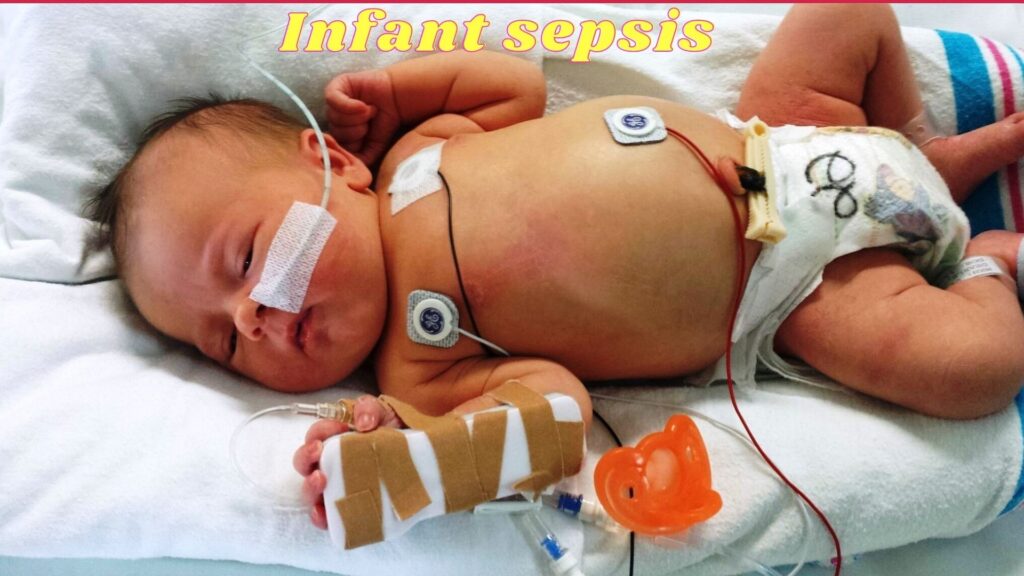Infant sepsis : symptoms, investigations & treatment
Infant sepsis
We have described in article :
Symptoms of infant sepsis
Investigations of infant sepsis
Treatment of infant sepsis
Risk factor of infant sepsis
prevention of infant sepsis

Symptoms of infant sepsis :
Mostly non-specific :
- Unable to suck.
- Poor cry, lethargy or abnormally sleepy.
- Hypothermia or fever.
- Poor perfusion.
- Hypothermia
- Absent primitive reflex.
Specific Symptoms /clinical feature :
- Central nervous system : Irritability, full frontanelle, seizure, vacant stare, high pitch cry, neck retraction. Presence of other feature suggestion meningitis.
- Gastrointestinal system : Feed intolerance, vomiting, diarrhea, abdominal distention, paralytic ileus, necrotizing enterocolitis etc.
- Respiratory system : Grunting, aponea, irregular breathing, fast breathing, severe chest indrawing or cyanosis.
- Cardiovascular system : Bradycardia or tachycardia, hypotension, poor perfusion, shock.
- Skin changes : Mooting, sclerema, multiple pustules, permbilical redness or foul smelling umbilical discharge.
- Haematological : Bleeding, petechiae, purpura, jaundice.
- Urinary : Oliguria e anuria.
Investigations of infant sepsis:
Sepsis screening :
- Total leukocyte count (<5000/mm3).
- Differential count (e.g. absolute neutrophil county low.
- Immature to total neutrophil (I/T) ratio 0.2
- Micro ESR 15 mm in 1 hour. Elevated haptoglobin (> 1mg/dl).
Other investigations :
- Blood culture.
- Urine culture
- CSF study to assess evidence of meningitis.
- X ray chest and abdomen.
- USG of brain or other as individualized.
Treatment of infant sepsis :
1) Supportive care :
- Maintenance of temperature maintaining optimum room temperature (>25°C wrapping warming in radiant water or incubator).
- Hypoglycaemia : by 10% dextrose
- Treatment of shock : Dopamine or dobutamine along with volume expander (normal saline, albumin, blood).
- In case of DIC : fresh frozen plasma (FFP), vitamin K. platelet infusion, exchange transfusion.
- Assess hypoxia by pulse oximetry and initiate oxygen therapy or ventilator support.
- Control of seizure by appropriate medication.
- Monitor for SIADH urine output, hyponatremia, serum and urinary osmolarity.
- Treat metabolic acidosis with bicarbonate and fluid replacement.
- Care of umbilicus :
- Feeding :
.Breast feeding
.If not possible the nasogastric feeding of expressed breast milk.
.If the baby cannot tolerate oral of nasogastric feeding, then Iv fluid (27% less than normal daily allowance).
2) Antimicrobial therapy :
- Empirical therapy : ampicillin plus gentamicin, or ampicillin plus cefotaxime.
- Duration of antibiotic therapy : usually 7-10 days or at least 5-7 days after a clinical response has occurred.
- For meningitis :
.Gram positive bacteria 14 days.
.Gram negative bacteria-21 days.
3) Best defense modulation:
- Granulocyte transfusion.
- Immunotherapy (IVIG).
4) Follow up : Every 4-6 hourly to monitor-
- Vital signs : heart rate, respiratory rate, temperature.
- Primitive reflex : suckling, rooting, moro and others.
- Skin condition : texture, colour condition, tissue perfusion and any mottling.
- Anterior fontanelle : any bulging or fullness.
- Abdomen : any distension, presence of bowel sound, passage of urine and stool.
- Any untoward sign : convulsion, apnoea, cyanosis etc.
Risk factors of infant sepsis / infection :
- Rupture of membranes > 18 hours.
- Maternal intra-partum fever > 100.4 °F.
- Low birth weight infant (<2.5 kg).
- Prematurity (<37 weeks).
- Chorioamnionitis.
- Male infants.
- Mother with group B Beta haemolyticus streptococci (GBS) infection.
- Repeated per-vaginal examination (P/V/E) in labour.
- Invasive procedures of monitoring.
Prevention of infant sepsis / infection:
- Proper antenatal care of the mother.
- Treatment of premature rupture of membranes (PROM) with proper antibiotic.
- Maintenance of all aseptic precaution during delivery of the baby.
- Proper care of the umbilical cord.
- Proper care of the skin, eye and ear.
- Baby should be kept warm and clean.
- Less handling of the baby.
- Hand washing before handling of the baby.
- Early diagnosis and treatment of infections.

naturally like your website but you have to take a look at the spelling on quite a few of your posts. A number of them are rife with spelling issues and I find it very troublesome to inform the reality on the other hand I will surely come back again.